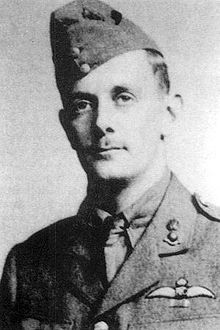Lanoe Hawker
Major Lanoe George Hawker VC , DSO . (* The 30th December 1890 in Longparish , Hampshire ; † 23. November 1916 near Bapaume ) was a British military pilot in the First World War . In his career he achieved nine (according to other sources: seven) victories .
Military successes
Hawker, who was originally a mechanic, joined the British Royal Flying Corps (RFC) before the First World War . He was considered a master tactician and was a talented aviator whose skills earned him a high reputation among his comrades. In aerial combat, he was aggressive and creative. His motto was “attack everything!”.
In the first years of the war he flew in No. 6 Squadron. Efficient fighter planes did not yet exist at that time, so that pilots often took carbines or even stones on board to combat enemy aircraft. Hawker himself armed himself with hand grenades and small bombs with which he was able to take a German airship from the sky in April 1915. For this achievement he received the Distinguished Service Order .
For the fight against enemy planes he attached a Lewis rifle to his Bristol Scout . The rifle was located a little to the side of the aircraft so as not to damage the propeller when in use . On June 25, 1915, he succeeded in shooting down three German aircraft. He destroyed two of them in the air. The third was so damaged after the fight that it went down behind its own lines. After these remarkable aerial victories, he was awarded the highest British war award, the Victoria Cross, as the first fighter pilot in history .
Hawker's influence in reorganizing the RFC
In Germany, the Dutch aircraft manufacturer Anthony Fokker developed his revolutionary interrupter gear in 1915 . With the help of this method, it was possible to shoot an MG through the propeller circle of an aircraft without damaging it. The Fokker E.III aircraft equipped with the new system turned into a serious threat to the Allied air forces in the following months. Hawker was among the first pilots to face this new threat.
The British leadership, recognizing Hawker's abilities, decided to put him in charge of No. 24 Squadron. Subsequently, he was responsible for some of the most important changes within the RFC. He divided his aircraft into closed groups and thus ensured a reduction in ineffective individual and group flights. Hawker's tactics and the new Airco DH2 fighter aircraft were instrumental in relieving the Germans of air sovereignty on the Western Front .
The fight with Manfred von Richthofen
On November 23, 1916, Lanoe Hawker was killed in an aerial battle with the 'Red Baron' Manfred von Richthofen . Richthofen's eleventh victory in the air was one of his toughest and most famous battles.
On the morning of November 23, Hawker was traveling with his unit on the Western Front when he encountered German Fighter Squadron 2 . In the air battle that followed, Hawker was harassed by a German Albatros D.II aircraft that was flown by Manfred von Richthofen. In the further course of the fight Richthofen always had a little advantage. On the one hand, this was due to the fact that the Albatros D.II. was the faster and more resilient machine. Second, Hawkers DH-2 had already used a lot of fuel and was no longer able to make a long flight. His only chance was to shake off the Red Baron and return to his airfield at Bapaume.
Richthofen followed the British for 35 minutes. Hawker was already very close to the ground and tried to shake off his pursuer with clever maneuvers. However, Richthofen could not be disturbed and brought himself into a favorable shooting position. When the two planes were close to the trenches of the front, Richthofen was able to fire a few precise volleys; Hawker was fatally wounded. The wreck of his plane was later found by German soldiers. The separated serial number and the Lewis MG from Hawkers machine were passed on to von Richthofen as a souvenir. Hawker has no known grave, but his name is mentioned in the Arras Flying Services Memorial in Arras .
The Allies lost one of their best tacticians and fighter pilots. Manfred von Richthofen of aerial victory was the start of his legendary career as an ace .
literature
- Arch Whitehouse: Aviator Aces 1914-1918 . Motorbuch-Verlag, Stuttgart 1970, pp. 251-253.
Web links
- Kurzbiografie (English)
Individual evidence
| personal data | |
|---|---|
| SURNAME | Hawker, Lanoe |
| ALTERNATIVE NAMES | Hawker, Lanoe George (full name) |
| BRIEF DESCRIPTION | British military pilot in World War I. |
| DATE OF BIRTH | December 30, 1890 |
| PLACE OF BIRTH | Longparish , Hampshire |
| DATE OF DEATH | November 23, 1916 |
| Place of death | near Bapaume , Somme department |
